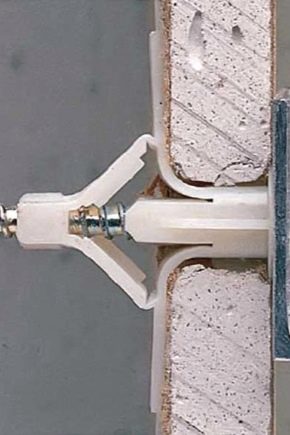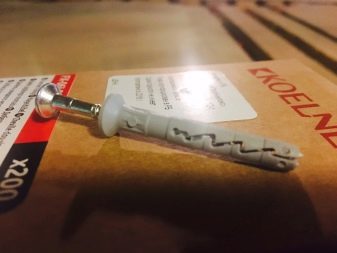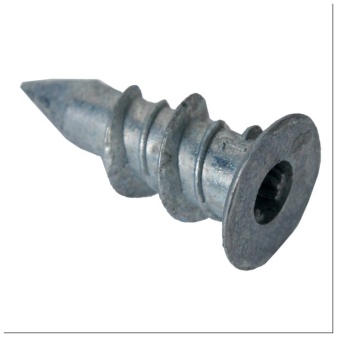How to choose a drywall plug?

In modern construction, there are many ways to fasten elements and structures to each other. The dowel was invented for fastening heavy parts. Each material has its own dowels. So, for hollow drywall, you cannot use elements that are suitable for a concrete base.
Peculiarities
Speaking about working with drywall, it is impossible to forget about the main fastener - the dowel. A photo frame or small picture can be hung on a freshly created plasterboard partition using a screw or self-tapping screw, but if you decide to attach something heavy to it that requires additional load, for example, a TV on a rotating mount or a wall cabinet, then you need to use special mounts. Thanks to this small element, the drywall sheet will not deform, its core will not collapse, and the suspended object will remain motionless in its place. For different types of dowels - different permissible load.

The construction market offers many options for dowels. They can vary in diameter and length. There are norms governed by GOST 28457-90. It is he who determines that the dowel should be a structure designed for installing a self-tapping screw.
Unlike other fasteners, fasteners that are intended for drywall are made of high quality metal or plastic and have a guaranteed fixation of the product to the gypsum board. For full fixation, the fasteners are equipped with a very important element - a sleeve, which can only be folded in a complete void. Under any other conditions, the liner will not work.


For a durable fastening of an element to drywall, it is necessary to know the load that this fastener can withstand. To find out this information, you only need to know the diameter and length of the fastener.


At home, there are usually three types of load: horizontal, vertical, dynamic.
- Horizontal the load is typical for shelves, pictures. Fasteners are chosen according to the weight of the product (6-10 mm) and the base material (30-50 mm for drywall).
- Vertical the load appears when you install a chandelier or air conditioner. With a screw diameter of 6 mm, the fastening element must enter the wall by at least 40 mm, and into the ceiling by at least 60 mm.
- Dynamic the load arises, for example, when attaching a ladder, gymnastic rings, "pear" or other sports equipment. In this case, vibration-resistant fasteners are required.


Sometimes, for better adhesion, the dowel is pre-lubricated with glue.
There are some features of the dowels that must be considered when choosing them:
- dowels of the same type, but made of different materials, for example: plastic or metal, differ only in the weight that they can withstand;
- for fastening to sheet material, the correct type of fastener must be selected, in which the sleeve is tightly pressed against the sheet.


How to use?
There is a classification of dowels according to various criteria.
Dowels are distinguished according to the method of fastening:
- fixed to the surface due to the force of friction;
- having various forms of dowels and bases.
There are two ways to screw the dowel into the wall: preliminary or through installation.


When pre-installation, it is necessary to drill a hole in the wall with a drill of a larger diameter, then install a dowel (spacer, nail, universal) and fix the necessary part with a screw. Using this method, for example, you can attach a shelf or a TV bracket with your own hands. For the installation of a plastic dowel, a special bit is offered in the package.


When using through installation, there is no need to drill the base: the fastening with its non-expansion part must pass through the “void” section. Usually this method is used for fastening facades, roofs, insulation.
Dowels are distinguished by the method of installation:
- hammered;
- screwed in with a special construction pistol.

Various materials are used for the production of dowels.
- Plastics, including polypropylene or nylon.
- Polyethylene. Light enough material, acid resistant. Keeps well in case of deformation. The advantage of the material is that it is anti-corrosion. Withstands temperatures up to -40 C. Minus: cracks may appear.
- Polypropylene. Unlike polyethylene, it has greater strength and durability. Withstands temperatures up to +140 C, but still loses the integrity of the body.


- Polyamide or nylon. Resistant material, which is distinguished by special vibration resistance, practically does not wear out and is insensitive to mechanical damage. That is why nylon is considered the most reliable material. Minus: installation in a room with high humidity is prohibited.
- Metal, including aluminum and stainless steel. Does not deform, has a higher wear resistance and bearing strength. If the metal from which the dowel is made is only galvanized, it is subject to corrosion. Brass or titanium alloy fasteners are very expensive and are only used in highly hazardous areas.


Drywall is a brittle, hollow material that belongs to the soft category. Be careful when drilling. You cannot use the punch mode - this may damage the integrity of the sheet.
Types and characteristics
Butterfly
The butterfly fastener is made of metal or polypropylene and has two wings "straightened" in opposite directions, which prevent the screw from spinning. It is used to fix objects with light weight: paintings, lamps. Disposable - not reusable. There is a possibility of dismantling the element.
To install the butterfly dowel, it is necessary to press the side elements to the center and carefully hammer them into the drywall sheet. At the time of installation of the dowel, the wings "straighten" on the other side of the gypsum board, evenly distributing the weight of the suspended element over the surface. After that, you can screw in the screw.

The standard sizes of this dowel are 8/28 and 10/50. For the first option, a 3.5 / 35 mm screw is suitable, for the second - 3.5 / 55 mm. Butterfly size 10/50 mm is capable of supporting up to 24 kg. For full disclosure, you will need a self-tapping screw with a length of no more than 55 mm.
Made of plastic. Sold folded.
Umbrella
Designed for heavier objects: due to its shape, it is suitable for fixing the chandelier to plasterboard ceilings. Cannot be dismantled.

When mounted, it looks like a regular umbrella. A closed dowel is inserted into the drilled hole. Thanks to the built-in spring, reaching free space, it opens up inside the gypsum board.
Able to withstand up to 35 kg.
Molly
One of the most expensive options for the dowel, which belongs to the category of "expandable". Suitable not only for drywall but also for suspended ceilings. When installed, the dowel clamps the plasterboard between the front and rear. This dowel can hold up to 35 kg. There is a possibility of dismantling.

Its advantage is that there is no need for a self-tapping screw: all necessary parts are included.To fix it, you need to drill a hole 8 mm in size, insert the dowel and press down on its side so that both teeth are tightly closed in the gypsum board. Then you just need to tighten the top element of the dowel so that the back part is tightly pressed against the sheet.
Made from metal only.
Driva
The easiest to use, therefore ideal for beginners who are just starting to get acquainted with a material such as drywall. Driva looks like a snail and is screwed in with a regular screwdriver until it stops. To facilitate screwing in, it is possible, but not necessary, to drill a 6 mm hole. Due to tight screwing into the core of the sheet, it can withstand loads of up to 25 kg. For the driva dowel, it is necessary to choose the correct length of the self-tapping screw, which will subsequently also be screwed into the dowel with a screwdriver. Such a screwdriver, falling into the void, twists into a knot, allowing you to hang on it something similar in weight to a kitchen cabinet.

It can be either metallic or nylon.
Legs
This fastener is made of metal. It has two pointed ends with triangular plates, which are called "legs" in professional language. The kit includes a screw.

Dowel nail
The second name of this element is DBM (quick mounting dowel). Does not require special skills and additional effort for installation. Has no screw. Does not involve subsequent dismantling. The dowel is inserted into the hole corresponding to its size, and then driven in with a nail until it stops. Suitable for curtain rods and skirting boards. It is reliable due to the fact that during installation it expands in three directions at once.

Nails are divided into two types: with a cap in the form of a fungus and a secret hat. They differ among themselves in the height of the side. The dowel with a fungus presses the elements more reliably. Using the example of fastening heavy skirting boards, it can be proved that the countersunk head will not provide the necessary fixation of the dowel.
Chemical anchor
It is a capsule with an adhesive liquid. The complex has a mesh sleeve that allows even a non-professional to fix the element.

Dowel for double drywall

For double drywall, special mounts are used. They have a drill bit that allows them to be easily screwed into the double sheet.
In addition to those listed, there is also a self-aligning dowel, strips and other types.
Manufacturers
The construction market also offers drywall plugs named after the companies that created them.
Fischer PD and PDS
Rounded nylon plug. Longitudinal ribs prevent twisting. During the screwing of the self-tapping screw, its tapered shank enters the plastic sleeve, forcing the stop wings to open. Withstands up to 15 kg.

Knauf-Hartmut (Knauf-collar)
The fastener sensation. Such a dowel in the wall can withstand up to 55 kg, in the ceiling - up to 6 kg. The set of such a dowel consists of a metal U-shaped bar, a locking sleeve, and two plastic guides.

For installation, a hole of at least 13 mm must be drilled, insert the plank and align the guides. Then insert the plastic sleeve through both guides until it stops, then spread them in different directions and remove. Thus, the plank is securely fixed in the drywall, into which the screw from the kit is subsequently screwed in.
Walraven BIS GOLD
This plug-in dowel is suitable for light to medium loads for screws with a diameter of 3.5 - 5.0 mm and a minimum length of 30 mm. The name of the fastener speaks for itself: you only need a hammer to install. During driving into the wall, the dowel wedges itself and does not scroll.
There are other manufacturers of drywall plugs, for example: TOX and KEW (Germany), HILTI (Liechtenstein), SORMAT (Finland).

To save on the cost of dowels, they are most often bought in bulk in China. Despite the quality, some branded dowels will vary greatly.
Be sure to find out the country of manufacture of the mount from the seller, because safety depends on this.
Advice
- Before starting work, you should find out the characteristics of drywall and determine the structure and weight of the attached element.
- Based on the characteristics of the dowels, choose the one that suits your particular situation.
- In addition to the characteristics of the dowel itself, it is necessary to choose the right screw: it should not deform or break the dowel inside the sheet.
- Objects weighing up to 5 kg (paintings, photo frames) can be attached to the gypsum board and without a dowel - on a self-tapping screw, while paying attention to maintaining the integrity of the sheet.
- Be sure to control the screwing force - you can pierce the drywall sheet through.

- Drill the sheet with a smaller diameter conventional drill. In this way, you will avoid skewing when screwing in the dowels.
- It is worth correctly calculating the weight per dowel and not exceeding this value. On average, it is considered that the load on the fasteners should not exceed 50 kg per 1 m2.
- If the drywall is faced with tiles or tiles, use a special victorious tip and drill a hole equal to the diameter of the dowel.
- The length of the hole in the plasterboard should be 5 mm longer than the screw.
- Be sure to clean the hole from dust and crumbs. This can be done using a conventional vacuum cleaner.
- It is best to use a metal profile for attaching elements to a plasterboard ceiling. An ordinary magnet will help you find it on the back of the sheet.


If for some reason you do not know what base material is in front of you, then you can check this by trial drilling. If a small fraction of a fine fraction, similar to dust, begins to pour out of the hole, rest assured that you are dealing with drywall.
For information on how to choose a drywall dowel, see the next video.













The comment was sent successfully.